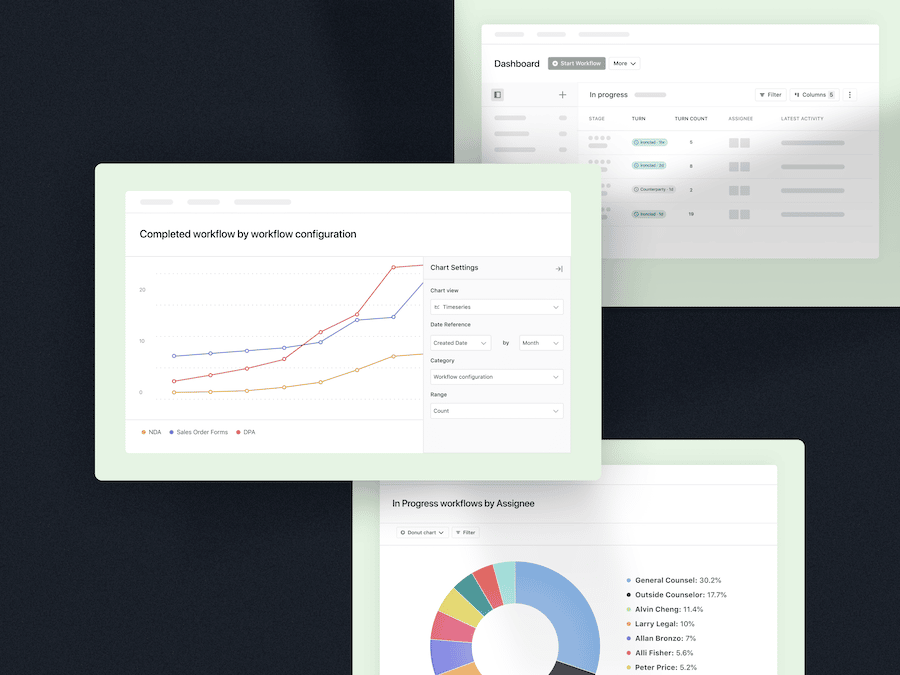Even a decade ago, “legal” and “technology” were words that were generally juxtaposed oxymoronically, if at all. Today, “legal technology” is a booming industry: in the last 2 years alone, 222 legal tech companies were funded to the tune of $457 million.
Legal tech is becoming increasingly necessary for modern legal teams. At the same time, it’s also becoming increasingly difficult to separate signal from the noise and understand the rapidly crowding legal tech landscape. In this blog, I review some basic technical concepts all modern legal professionals need in order to evaluate how legal tech might transform your legal team.
I’m a software engineer, but don’t worry—no technical expertise is required. This blog is written for non-technical General Counsel, lawyers, and legal operations professionals who are just starting to explore the bold new world of legal tech.
1. First things first: What is the cloud, anyway?
The cloud simply refers to remote hosting of software and services. Services like Gmail and Netflix are examples of cloud-based offerings—anyone with an internet connection can use them without having to install any software.
In the past, companies stored all their applications and information “on premises”—that is, on hard drives located on-site. This arrangement required dedicated IT resources and was difficult to scale over time. But with the advent of reliable high-speed internet, relatively cheap data storage, and a proliferation in secure off-site vendors, remote (or “cloud-based”) software and services have become the standard for most legal technology offerings.
Key Takeaway: Cloud-based legal tech software gives your team access to best-in-class security, ensures that your team can scale flexibly, and dramatically lowers the cost of IT maintenance.
2. What is artificial intelligence? What is machine learning? Are the robots on our side?
In the legal technology context, artificial intelligence (AI) and machine learning (ML) typically refer to advanced pattern recognition. Given enough information on problems and solutions from the past, computers can learn to simulate human problem-solving capabilities.
The key requirement here, though, is “enough information.” To date, AI and ML have been most successful in areas where there is abundant training data and the stakes are relatively low, such as filtering emails for spam or interpreting voice commands from an iPhone. In areas where there isn’t enough data, or where human judgment is still needed, AI and ML still haven’t taken center-stage.
I haven’t seen examples of this working in legal, for the simple reason that there’s usually not enough data, and without data, computers are (essentially) really dumb. How dumb? I’ll give an example I studied at Carnegie Mellon: CAPTCHA, everyone’s favorite online shopping checkout blocker. Have you ever wondered why CAPTCHA is effective at separating humans from bots? It’s because humans are smart—especially when it comes to synthesizing context—and computers can only become smart after a human tells it to make a certain calculation many, many (millions— billions, even) of times.
Key Takeaway: Before implementing an AI or ML solution, make sure that the solution is a good fit for the problem you’re trying to solve, and that the company’s offering has been thoroughly tested in the field. Understand how much data is being fed into the system, and where that data is coming from. Generally speaking, a good rule of thumb is that computers and humans will outperform either computers alone or humans alone.
3. Are there different types of data I should know about, or is all data the same?
Any type of information qualifies as data, but there are two specific types of data that you need to understand in order to evaluate legal technology.
Metadata is data about data. For example, a contract’s metadata might include its author, the date and time it was created, and the last person to edit the document. Most modern legal teams don’t do anything with their metadata because they don’t have a great way of collecting it—but access to metadata can provide valuable insights around your legal team’s process and even insights around substantive issues.
To provide a process example, every customer who uses Ironclad can report to their business functions how many contracts have been processed and how quickly. And customers like HotelTonight can use metadata on governing law, tax rate, and margins to inform front-office finance and sales decisions (read more here).
Training data is the information that AI/ML applications need to be fed in order to begin learning how to solve problems. For example, the training data for a spam filter could be millions of legitimate emails and thousands of emails marked as spam. Given this training data, an AI/ML application could quickly uncover common indicators of illegitimate emails. Without training data (or with insufficient training data), the same application might draw inaccurate conclusions or solve a problem incorrectly. In fact, you’ve witnessed this firsthand when your inbox incorrectly flags an email from a friend or a colleague as spam.
Key Takeaway: AI/ML legal technology is only as good as the data it’s based on. For this reason, it’s important when evaluating this kind of technology to evaluate the quality of training data. How is it being gathered?
4. What is an algorithm?
An algorithm is a clear process or set of rules that dictates how a computer will respond given a certain set of inputs. Algorithmic trading, for example, refers to buying or selling stocks based on a predetermined set of criteria (e.g., selling a stock when it dips below a certain threshold).
Algorithms can be hard-coded or automatically generated. Hard-coded algorithms are predictable, but time-intensive, while automatically generated algorithms sacrifice accuracy for ease of use. Regardless, we don’t know of any legal technology software that requires users to input algorithms, so what’s most important is just that you understand what they are.
Key Takeaway: Algorithms are the rules that dictate how legal technology will behave. The precision and quality of these rules determines how effective the software is. Well-designed algorithms can help automate routine tasks, while poorly designed algorithms create mistakes and legal liabilities.
5. Okay, but I keep hearing about analytics…
Like most of the terms on this list, the word analytics has been overused to the point of meaninglessness. In business or legal contexts, however, analytics typically describes the use of data to improve operational efficiency. For example, analytics on a legal team’s efficiency might center on the number of contracts executed per week, or the average time between contract proposal and finalization. More data isn’t always helpful, though. The most important thing for any team is to make sure that analytics serve a business purpose; otherwise, they’re just a distraction.
Key Takeaway: Analytics can help your team track the efficiency and effectiveness of different legal technology, but only if you define your metrics early on and keep them consistent over time.
6. What’s the blockchain? What are smart contracts?
A blockchain is a list of records that can’t be changed, only added to. While records have existed for millennia, they’ve always been at risk of modification: a piece of paper can be forced, a database could be hacked and modified, etc. The security of a blockchain is guaranteed by its use of impenetrable cryptography. Changing a blockchain would require computers that are more powerful than any that currently exist.
Smart contracts are contracts that occur on the blockchain. Because these contracts are visible to all and can’t be changed, smart contracts eliminate the need for third-party enforcement or verification of contracts (in theory). Smart contracts are promising, but they haven’t been widely implemented or tested yet.
Bottom line: what does this mean for your legal team? Probably not much, unless you’re working for a blockchain company!
Key Takeaway: While companies and governments have embarked on interesting blockchain test cases, most legal teams won’t see benefits from blockchain-based solutions right now. The key benefits of blockchains and smart contracts, which are immutability and decentralization, are probably not your company’s most immediate concerns.
Ironclad is not a law firm, and this post does not constitute or contain legal advice. To evaluate the accuracy, sufficiency, or reliability of the ideas and guidance reflected here, or the applicability of these materials to your business, you should consult with a licensed attorney. Use of and access to any of the resources contained within Ironclad’s site do not create an attorney-client relationship between the user and Ironclad.


